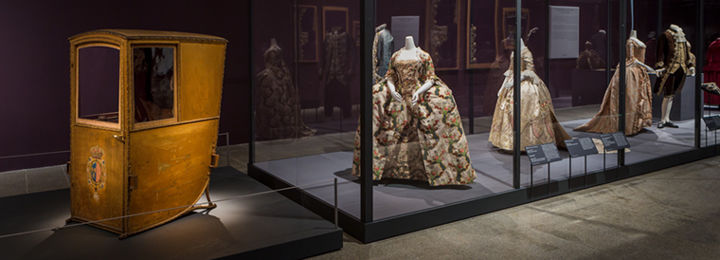
Editors Note: Even though most of the fashion media is focusing today on the Met Ball in support of Heavenly Bodies at the Costume Institute, Nadine Stewart and I agreed that it was important to take a virtual visit to the Met’s current show (on view through July 29), Visitors to Versailles, 1682-1789. Here is Nadine’s review:

The halls of the Metropolitan Museum of Art are busy this spring getting the Byzantine and Medieval galleries ready for the upcoming Costume Institute exhibit. High platforms containing one mannequin each are up in the hallways on each side of the grand stairway while in the back in the medieval galleries shrouded mannequins await their unveiling. But summer visitors should remember that the Met is a place for many interests. Go up to the special exhibition gallery on the second floor for an exhibit that is about spectacle, fashion, and power in Versailles, the place to see and be seen in the seventeenth and eighteenth centuries, the high point of royal pageantry in all the world.
What makes this exhibit so pleasurable is its point of view. It draws on the accounts of travelers, diplomats, and courtiers to tell the story of the lure of a hunting lodge converted to the largest palace in the world, they symbol of France’s might and power. The pleasure is increased with the audio guide [ The onine version of the exhibit includes audio]. Usually these guides comment on the art in more detail. This guide uses actors who read the words of the visitors of the day. There’s no better way to get a feeling for the effect this huge palace had at the time.
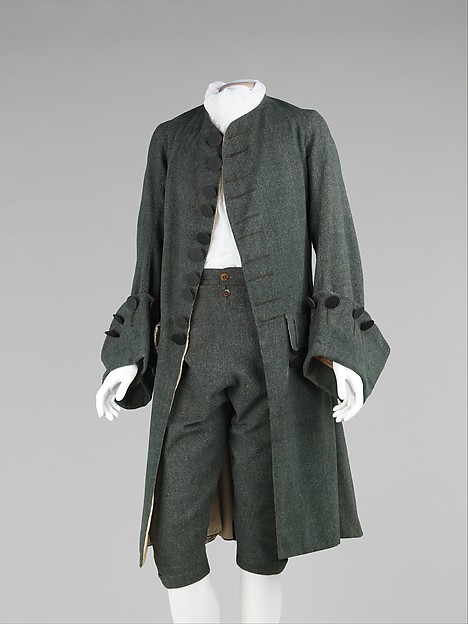
Each gallery has a theme. The first deals with how visitors got there. Versailles is twelve miles for Paris accessible by boat (by far the most enjoyable trip), sedan chair or private coach, or large sixteen seat public carriages which lurched and swayed putting their passengers uncomfortably close to each other. Once the visitor arrived, the next problem was acquiring the right clothes to wear in court, so the first thing we, the visitors to the exhibit, see is a display of eighteenth century dress for men and women. The contrast between a wool riding habit and a man’s wool suit, both from England, and the silk French Robe à la Française and Habit à la Française is striking. The huge case in the gallery has several examples of both, including the blue silk habit of Count Axel Fersen, rumored lover of Queen Marie Antoinette. You can walk around the case and see the garments from all angles.
One had to appear in the court in French clothes and be coifed in French style, so there were places in Paris where one could purchase the right garments and be groomed for presentation. In 1754, British architect Robert Adam wrote to his mother about his transformation: “Would you incline to know the appearance of your once plain friend? A most Frenchified head of hair, loaded with powder, ornaments his top; a complete suit of cut velvet of two colours, his body . . .”
Once properly dressed though, the visitor found Versailles a very public place where the King was often on view to his subjects. The king took daily walk in the gardens of Versailles, which is the theme of the next gallery. They were a wonder with a menagerie featuring rare animals and birds like the ostrich and camel and a labyrinth. Both of these were destroyed when they fell into disrepair later n the eighteenth century. We can get a sense of the magnificence of these gardens from the large landscape paintings, which show the grounds and, even more important, the crowds promenading along the paths. If one visits Versailles today, the place is thronged with tourists. It’s easy to see from these paintings things have not changed, only the fashions. Another gallery shows how the royal family was on display most of the day from the lever, a formal awakening of the King only accessible to special visitors, to the procession to chapel for mass and the Grand Couvert, a banquet held several times a week where the public could watch the King and his court eat. Apparently, the French themselves were just as fascinated with their king as foreign visitors, so these events were well attended.
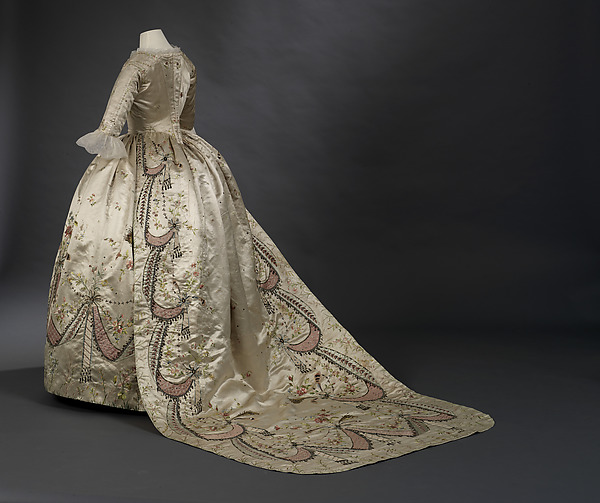
European ambassadors to France were required to follow rigid rules for presentation to the court. One particularly poignant painting here shows the Dutch ambassador being presented to a tiny Louis XV around 1720. One British ambassador’s wife was weighted down with diamonds worth 60-thousand pounds and a robe a la francasie she found very difficult to maneuver. There was a special technique for moving properly when being presented to the king. Coaching was required since one could never turn away from the king. One woman forgot the trick of kicking her train out behind her as she left the King’s presence and had to be rescued and disentangled.
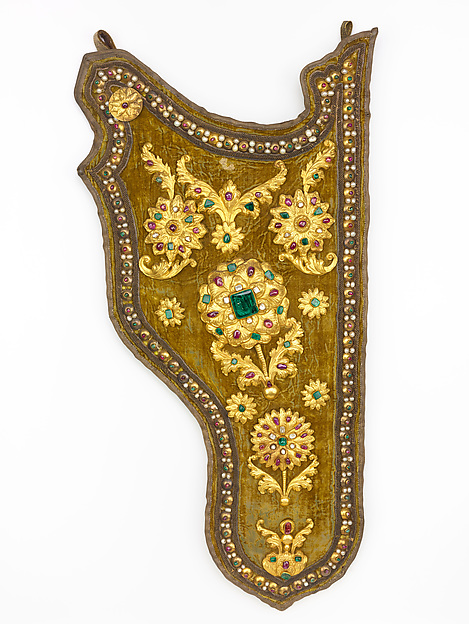
Thousands of spectators showed up for the exotic diplomats from Asia and the Middle East. Missions came from Siam, India, Persia, and even the kingdom now known as Vietnam. These ambassadors were urged to wear their national dress to emphasize the reach of the French state. A delegation from Siam presented the King with a cannon decorated in silver, which is on display along with a sampling of other diplomatic gifts–a huge carpet, a high lompok or Siamese conical hat of rank with its carrying case, a bejeweled powder flask and quiver. Portraits of the diplomats in their finery, which often inspired fashion crazes, are throughout the gallery. The most special one shows the very young Nguyen Phuc Canh, seven-year-old price of Vietnam in 1787. He wears an “intricately tied turban that inspired French wig makers.”
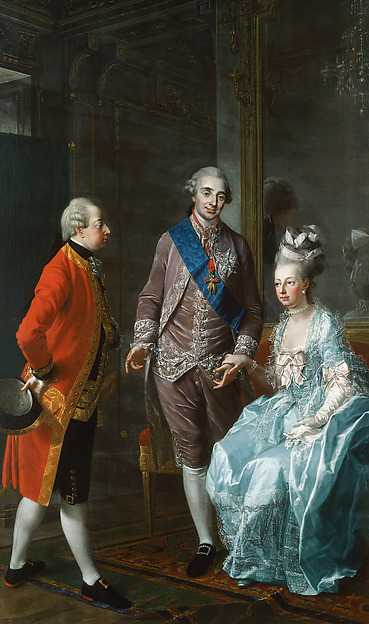
Foreign royalty came to Versailles too, often incognito, which meant they could bypass rigid etiquette though they were still treated to balls, ballets, and banquets. Some royal visitors were more successful than others. Gustave III of Sweden visited twice, while Queen Marie Antoinette’s brother Holy Roman Emperor Joseph II insisted on being treated as a sovereign on his visit. This probably did not contribute to the popularity of the Austrians in the French court including the Queen herself. Royal portraits and gifts line this gallery including one which shows Joseph II meeting the Queen and her husband, Louis XVI.
Visitors came to Versailles as part of the grand cultural tour of Europe. This group included American form the New World. After 1776 though, American diplomats came to Versailles seeking money to fund their revolution against England. Benjamin Franklin spent many years there and became quite a celebrity. He shrewdly dressed in a plain plum-colored suit in court, a simple one with no extra embellishment like embroidery. That suit is on display here [on loan from the Smithsonian] along with a fine portrait and the Severes porcelain commemorating the signing of our alliance with France—an alliance Louis XVI could not afford that contributed to his downfall in the French Revolution. Versailles became decrepit and fell into disrepair under Louis XVI. Visitors commented on the shock of seeing beggars outside its gates. On October 5, 1789 a mob lead by the market women of Paris stormed the gates of the palace. The royal family tried to flee to the Netherlands but was caught and taken into custody. Courtiers left Versailles to save their own lives. A Russian came to the virtually abandoned palace in 1790. According to him, without its courtiers and visitors, Versailles was like a body without a soul, but still compelling.
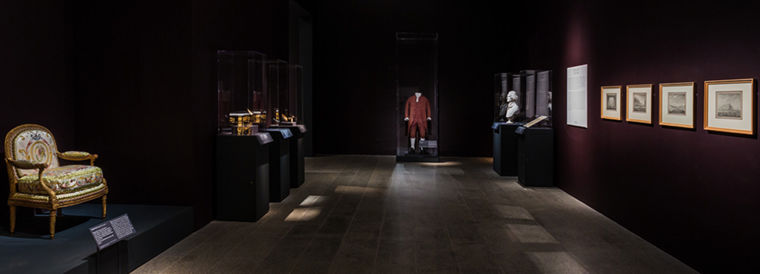
Visitors to Versailles combines paintings, artifacts, and first-person accounts to give a rich picture of the lively court during the seventeenth and eighteenth centuries. Right before the French Revolution, Gouverneur Morris, an American diplomat who succeeded Franklin, ridiculed Versailles as “an immense monument [to] the vanity and folly of Louis Fourteenth.” Perhaps it is, but it also still casts a compelling spell that showcases France and French culture. Visitors still flock there and French leaders like Emmanuel Marcon use it as a stage for their diplomatic events. Strolling through the galleries, I gained a sense of what my own visit might have been like all those centuries ago. It’s a story worth telling.
The Exhibition Catalog was just published today and is available here:

Nadine Stewart is currently an adjunct professor of Fashion Studies at Montclair State University. She has a Master’s degree in Fashion and Textile Studies from the Fashion Institute of Technology (FIT) and a BA in English Literature from Dickinson College. She has a longtime interest in millinery and milliners and is currently working on a social history of American milliners. She lives in New York City, right behind FIT!
